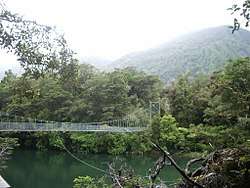Davey Gunn
David John Gunn, generally known as Davey or Davy, (18 September 1887 – 25 December 1955) was a keen promoter of the attractions of the Hollyford Track and from 1936 guided parties to them. A farmer and bushman he ran his almost wild cattle in the glacier-cut Hollyford Valley in Fiordland, South Westland, New Zealand.
Gunn was the fourth of five children of Scottish parents, Isabella Grierson Robertson and her husband, Alexander Gunn. A one-time shepherd,[1] Alexander Gunn ran a sheep farm of 27,000 acres in Central Otago.[2] For secondary schooling David lived at Hook near Waimate with his maiden aunts on their 500 acre farm.[2] Matriculating and leaving school he briefly followed other family members into Dalgety's working in one of their many branch offices as a clerk before deciding a desk job did not suit him.[3] He went back to work on and later manage the farm at Hook.[2] He underwent military training at Trentham in 1918 but was too late to be sent overseas.[3]

He went farming on his own account 100 miles south of Waimate at Sutton. On 10 July 1919 at Morven near Waimate he married Ethel May Willetts, a confectioner. They were to have two daughters, Isabel and Dorothy, and a son, Murray.
George Gunn, an early runholder, mapped some of the Hollyford Valley in 1861. In 1926 David Gunn bought freehold land there from remaining original settlers, the McKenzie family. He increased his Hollyford landholding in 1929, just before the onset of the Great Depression, by acquiring four leases totalling more than 25,000 acres. He then moved to the valley, establishing his solitary base at Deadman's Hut on the banks of the Hollyford River. Gunn cut a number of well used tracks and erected huts in the more remote parts of his run.
His wife took their children to Oamaru to be educated and Gunn returned to his family for brief visits only twice a year.
Fox Moth crash
Gunn came to public attention on 30 December 1936 with a speedy journey to bring assistance to the injured passengers of a de Havilland Fox Moth cabin plane he had seen crash into the sea at Big Bay. He covered the 90-kilometre, four-day journey in just 21 hours, a feat which earned him a King George VI Coronation Medal the following year.
Hollyford Track and tourism
.jpg)
In 1936, Gunn began guiding tramping parties down his Hollyford Track, and would continue doing so until his death in 1955. Friendly and hospitable by nature, and possessing considerable personal charm, Gunn became a well-known and popular figure. He was respected for his bushcraft, his energy, and his knowledge of the area.
On Christmas Day 1955, Gunn was fording the Hollyford River on horseback near Hidden Falls, with a 12-year-old boy mounted behind him. The horse stumbled and fell, and both riders were seen to find their feet in the river, until the horse stood up and they were both swept away and drowned. Gunn's body was never found.
After his death his son, Murray, continued to guide trampers in the area, and started "Gunn's Camp", a rest-stop for trampers with store and small museum, which still stands near the southern end of the track, around 10 km from the Milford Sound-Te Anau highway.
References
- ↑ Owen, Alwyn. "Gunn, David John". Dictionary of New Zealand Biography. Ministry for Culture and Heritage. Retrieved 24 October 2017.
- 1 2 3 Waimate Daily Advertiser, page 3, 17 May 1917
- 1 2 Julia Bradshaw (with Murray Gunn), The Land of Doing without, Davey Gunn of the Hollyford, 2007, Canterbury University Press. ISBN 9781877257537
External links
- "History of Gunn's Camp • Gunn's Camp". Gunnscamp.org.nz. Retrieved 24 October 2017.
- "Super tramp". Smh.com.au. Retrieved 24 October 2017.